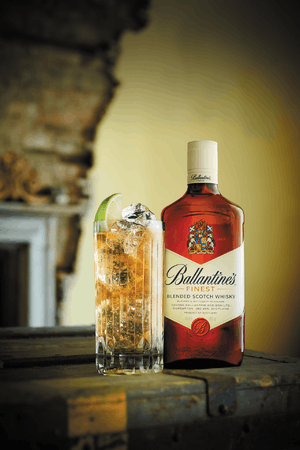Ballantine's

 | |
| Type | blended Scotch whiskies |
|---|---|
| Manufacturer | Pernod Ricard |
| Introduced | 1827 |
Ballantine's is a range of blended Scotch whiskies produced by Pernod Ricard in Dumbarton, Scotland.
The Ballantine's flavour is dependent on 50 single malts, four single grains and in particular the fingerprint malts from Miltonduff and Glenburgie. The brand has won many accolades and awards for its products.
The world's second highest selling Scotch whisky,[1] it has historically been strong in Southern Europe,[2] where it was among the first Scotch whiskies to gain a foothold in the market.
History
The heritage of Ballantine's Scotch whisky can be traced back to 1827, when farmer's son George Ballantine set up a small grocery store in Edinburgh supplying a range of whiskies to his clientele.[3] In 1865 George delegated the store's operation to his eldest son, Archibald, while he opened a larger establishment in Glasgow. Here he concentrated on the wine and spirit trade, catering to clients which included the Hindu Royal Family. He also began to create his own blends. These inspired additional demand, drawing second son, George junior, into the business. Trading as "George Ballantine and Son Ltd", the firm added a bonded warehouse and began to export their Scotch. George senior retired in 1881, George junior taking over, and died 10 years later at 83.
Business thrived under George junior, and the family sold out profitably to the firm of Barclay and McKinlay in 1919. Building on the reputation and goodwill of the "Ballantine's" name, the new owners focused on developing it as a brand for their blended whiskys. When increasing resources were needed to compete fully in the growing world market, the internationally experienced Canadian distilling concern of Hiram Walker Gooderham & Worts acquired Ballantine's in 1937. The same year the company received the Grant of Heraldic Arms featured on their bottles, recognising George Ballantine & Son as an "incorporation noble on the Noblesse of Scotland".
The new owners' first task was to secure fillings, to which end the Miltonduff and Glenburgie Distilleries were purchased, and a massive new grain distillery – the largest in Europe – built at Dumbarton. During the 1960s the company turned to Europe - at that time an unexplored market for Scotch whisky – and by 1965 had secured such a strong foothold there that it resolved to gear the home trade to supporting the overseas business.
Strong distribution and the popularity of Scotch whisky in the mid-1980s were key influencers in growth. Ballantine's was named the number one brand in Europe and the third largest in the world in 1986 with the oldest product Ballantine's Finest. In Korea, Ballantine's is the clear number one in the super-premium category with its ever-popular Ballantine's 17 in addition to 21 and 30. In 1988, the Company became part of the global beverage conglomerate Allied Domecq.
In 2002 the large Dumbarton Grain distillery was mothballed, with production shifting to the Strathclyde Grain distillery in the Gorbals of Glasgow. In 2005 Ballantine's was acquired by Pernod Ricard. Ballantines still maintain a large bonded warehouse complex in Dumbarton East and a bottling plant to the North of the town.
In 2006, Sandy Hyslop was appointed as Ballantine's Master Blender – the 5th Master Blender in Ballantine's 180-year history.
Products
Ballantine's produces a range of seven expressions with various characteristics and age statements:
- Finest: blended – "soft, sweet and complex"
- Limited: blended – "creamy soft and smooth"
- 12-year-old: blended – "fresh, soft, and nutty"
- 12-year-old "Pure Malt": blended malt – "honey sweet, spicy and deep"
- 17-year-old: blended – "creamy, harmonious and oak-sweetness"
- 21-year-old: blended – "spig, aromatic and heather smoke"
- 30-year-old: blended – "rich, oak influenced and lingering"
- 40-year-old: blended – "incredible depth, complex and extremely fruity"
Sponsorship
- Scottish Open Golf Tournament
- Australian A-League Football, Season 2007–08 to current
- Dumbarton Football Club
- Boiler Room
See also
References
- ↑ "Let Me Tell You About Whisky: Taste, try & enjoy whisky from around the world - Neil Ridley, Gavin Smith". Retrieved 2016-09-11.
- ↑ Olly Wehring, Pernod Ricard lagging Diageo in Scotch despite China leadership - analyst, just-drinks.com, 22 May 2012.
- ↑ "Eyewitness Companions: Whiskey - Charles MacLean". Retrieved 2016-09-11.
External links
- Ballantines Official Site
- Pernod Ricard website
- http://www.leaveanimpression.de/
- Leave an impression website sponsored by Ballantine's
- Leave an impression website (Germany)
- Leave an impression website (Portugal)